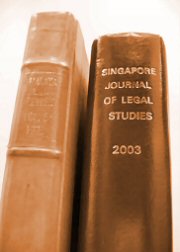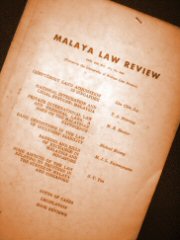|
Archive |
2386 records match your query:
| 211. | MARCH 2016 Issue | p.169 | |
| | The New 'Asplenium Clause' — Unconscionability Unwound?
Garth C Wooler • [2016] Sing JLS 169 (Mar)Just at the point where the unconscionability exception to the autonomy principle pertaining to letters of credit and demand guarantees appears to have finally emerged fully developed, the Singapore Court of Appeal has recognised the right of parties to contractually limit the range of causes of action available where the parties enter into a dispute. Finding such contractual terms enforceable has now taken the unconscionability exception almost entirely out of play and simultaneously shifted the power balance to the beneficiary while making the letter of credit product more attractive to rational buyers. The effect of the new 'Asplenium Clause' is yet to be fully seen but this paper concludes that in the immediate term, boilerplate clauses will be entered into every contract of sale that requires a guarantee to be provided, thereby virtually eliminating unconscionability as a grounds for enjoining against abusive calls on independent guarantees.
[Full Text]
| | 212. | MARCH 2016 Issue | p.183 | |
| | Legislation and Case Notes: Contributory Negligence and Apportionment
Margaret Fordham • [2016] Sing JLS 183 (Mar)In both the UK and Singapore, the legislation governing contributory negligence provides that in cases where the claimant has been contributorily negligent his damages should be reduced to such extent as the court considers just and equitable given his share in the responsibility for the damage he has sustained. As this is a rather general exhortation, it offers limited practical guidance. More specific assistance is to be found in a number of authorities, the most notable of which is probably Stapley v Gypsum Mines Ltd, where Lord Reid famously observed that as well as looking at the blameworthiness of both defendant and claimant, it is also necessary, when apportioning responsibility, to consider the relative importance of the claimant's actions. One of the most common situations in which contributory negligence is pleaded successfully is in relation to claims arising from road accidents, and in particular accidents involving pedestrians who are knocked down by drivers. In this context, more specific guidance on apportionment is to be found in decisions such as those of the House of Lords in Baker vWillough by and the English Court of Appeal in Eagle v Chambers, which suggest that, due to the dangers inherent in driving and the disparity in the potential for causing harm between a driver and a pedestrian, a higher burden is likely to be placed on the driver.
| | 213. | MARCH 2016 Issue | p.194 | |
| | Legislation and Case Notes: A New Framework for Self-Regulation
Markus K Labude • [2016] Sing JLS 194 (Mar)On 18 August 2015, Parliament passed the Human Biomedical Research Bill, which establishes two separate, but related, frameworks for the regulation of human biomedical research and tissue banking.2 The aim of these frameworks is "to protect research subjects and tissue donors, so that dealings are conducted in an ethical and responsible manner. The Minister of State for Health, in moving the Bill however, was careful to emphasise that the Ministry of Health's ("MOH") intention is to use the HBRA as an instrument "to ensure the safety and welfare of research subjects whilst not stifling sound, ethical research."
| | 214. | MARCH 2016 Issue | p.209 | |
| | Book Reviews: The Constitution of Singapore: A Contextual Analysis by Kevin YL Tan
Michael Dowdle • [2016] Sing JLS 209 (Mar)Kevin Tan's The Constitution of Singapore: A Contextual Analysis gives a clear and easily digestible introduction to the constitutional law of Singapore. This is exactly what this series is designed to do. It is highly recommended to anyone who wants a very readable and informative introduction to Singapore's constitutional system.
| | 215. | MARCH 2016 Issue | p.211 | |
| | Book Reviews: The Jurisprudence of Lord Hoffmann: A Festschrift in Honour of Lord Leonard Hoffmann by Paul S Davies and Justine Pila, eds
Margaret Fordham • [2016] Sing JLS 211 (Mar)In April 2014, a conference was held at St Catherine's College, Oxford, to mark the 80th birthday of Lord Leonard Hoffmann, widely recognised as one of the greatest jurists of our time. This volume brings together as a festschrift edited versions of the papers delivered at that conference. All are written by academics with current or former ties to the University of Oxford, the institution with which Lord Hoffmann's legal career is inextricably linked. For it was to The Queen's College, Oxford that Lord Hoffmann travelled as a Rhodes scholar from his native South Africa in 1954 to study for the Bain Jurisprudence and Bachelor of Civil Law—subsequently winning the Vinerian Scholarship for his performance in the final examinations and being appointed Stowell Civil Law Fellow at University College—and it was to Oxford that he returned as a Visiting Professor when he retired from the Judicial Committee of the House of Lords in 2009.
| | 216. | MARCH 2016 Issue | p.214 | |
| | Book Reviews: Corporate Law by Hans Tjio, Pearlie Koh and Lee PeyWoan
Luh Luh Lan • [2016] Sing JLS 214 (Mar)For a long time, Professor Walter Woon's seminal work on the Singapore company law has been the sole authoritative text in this area. However, as Singapore continues to position itself as a prime location for legal services and commercial dispute resolution in Asia, a single company law book may not be sufficient to serve the growing needs of the legal profession and the law students. Our legal professionals require more indigenous academic writings that embrace both the intellectual rigour and practical reality to guide them in their day-to-day work. At the same time, our law students yearn to read more books that can challenge their way of thinking and inspire them to love the area of law in which they are studying. It is therefore very heartening to see all these qualities incorporated in the latest corporate law book jointly written by our three prolific local legal scholars.
| | 217. | MARCH 2016 Issue | p.216 | |
| | Book Reviews: Law of Partnerships in Singapore Including LLP and LP by Yeo Hwee Ying
Geoffrey Morse • [2016] Sing JLS 216 (Mar)Partnership law is one of the great survivors of English colonial rule. The basic precepts of the United Kingdom ("UK") Partnership Act, 1890 (UK), 53 & 54 Vict, c 39 [UK Partnership Act] can still be found in Australia, Canada, New Zealand, Nigeria, India, Malaysia and even Ireland. The same is true of Singapore (there is a very useful appendix to the book giving a comparative table of the partnership statutes of the UK, Singapore and Malaysia). It follows that many of the national decisions on partnership law can be translated across boundaries. In some areas there have been different developments from the Partnership Act (such as the nature of a partner's interest in property) whereas in others there is unanimity.
| | 218. | JULY 2015 Issue | p.1 | |
| | Tools for Immediate Regulatory Tax Implementation: Subsidiary Legislation vs Legislation by Press Release
Chen Jianlin • [2015] Sing JLS 1 (Jul)A pertinent worry plaguing the implementation of economic regulations is the circumvention manoeuvres conducted by private entities during the time-consuming legislative process typically associated with legal change. During the recent imposition of stamp duties designed to curb its exuberant property market, the Singapore government utilised two distinct mechanisms—subsidiary legislation and legislation by press release—to eliminate any window of tax avoidance arising from the time lapse between the initial public announcements and formal implementation. This Article utilises this episode of economic regulation to examine legal and normative considerations regarding these two mechanisms that can be employed by the executive branch to effect immediate legal change. The Article argues that while both mechanisms are legal and are practically indistinguishable under the current legal framework and political reality in Singapore, the increased possibility of a more competitive political landscape necessitates greater legal constraints on the subsidiary legislation mechanism and greater political awareness of the legislation by press release mechanism.
| | 219. | JULY 2015 Issue | p.26 | |
| | Regulating Digital Financial Services Agents in Developing Countries to Promote Financial Inclusion
Evan Gibson, Federico Lupo-Pasini and Ross P Buckley • [2015] Sing JLS 26 (Jul)Limited access to bank branches excludes over one billion people from accessing financial services in developing countries. Digital financial services offered by banks and mobile money providers through agents can solve this problem without the need for complex and costly physical banking infrastructures. Delivering digital financial services through agents requires a legal framework to regulate liability. This article analyses whether vicarious liability of the principal is a more efficient regulatory approach than personal liability of the agent. Agent liability in Kenya, Fiji, and Malawi is analysed to demonstrate that vicarious liability of the principal, coupled to an explicit agreement as to agent rewards and penalties, is the more efficient regulatory approach.
| | 220. | JULY 2015 Issue | p.46 | |
| | Regulation of Equity Crowdfunding in Singapore
Hu Ying • [2015] Sing JLS 46 (Jul)Equity crowdfunding, a fairly new form of financing, has promise as a means to finance legitimate start-up businesses or projects which are unable to obtain funds from traditional sources, eg, banks, venture capitalists and angel investors. However, the cost of complying with existing securities regulations is likely to make equity crowdfunding impractical for the businesses most likely to need it. This paper will consider the rationale for facilitating equity crowdfunding in Singapore, assess the need for additional exemptions for equity crowdfunding, and propose legal reforms which seek to strike a balance between capital formation and investor protection.
| |
|
|


 |







